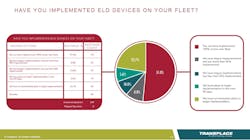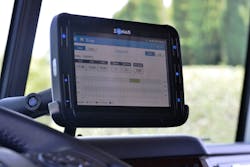Confirming some common assumptions, a new survey says that small fleets have been slow to implement electronic logs, that the coming electronic logging device (ELD) mandate will impact utilization (though no one is sure by how much) and, critically, drivers are leaving the industry because of e-logs. On the plus side, e-logs have reduced logging and HOS violations, and carriers do anticipate some operational benefits from ELDs, according to the survey more than 400 carriers of various profiles by Transplace, a transportation management services and logistics technology company.
“While created to improve safety within the transportation industry, the Federal Motor Carrier Safety Administration’s ELD mandate has left shippers and carriers with a lot of questions: how will this impact driver productivity; will drivers leave the industry as a result; will smaller carriers close up and leave the industry,” said Frank McGuigan, president and chief operating officer, Transplace. “This survey allowed Transplace to hear directly from our carrier partners and gain first-hand insight into how they are responding to the mandate and their expectations for how the use of ELDs will impact their businesses.”
Among the key observations:
ELD implementation varied heavily by fleet size: The study revealed that there is a significant difference in the amount of implemented ELDs between large and small fleets. Eighty-one percent of large fleets (more than 250 trucks) reported that they had achieved full ELD implementation, with the remaining 19% working towards implementation. Conversely, small fleets (less than 250 trucks) have been much slower to integrate ELDs, with only 33% having fully integrated ELDs into their fleet. Another 29% have begun the implementation process, while the remaining 38% have no immediate plans to begin implementation.
Among the sentiments expressed by the survey respondents, many noted that they are delaying implementation of ELDs until the legal challenge of the mandate by the Owner-Operator Independent Driver Assn. (OOIDA) has been decided. (Oral arguments in that case were presented in federal court Tuesday.)
While fleets reported driver concerns over lost time due to detention, traffic, and problems finding parking when the clock is running out, others said drivers have been glad to rid themselves of the hassle of maintaining paper logs and have found that they longer feel pressure to exceed HOS limits.
Capacity and utilization expected to change, but the amount varies: While most carriers expect their capacity or utilization to be affected as a result of ELDs, 56 percent of large fleets expect their utilization to decrease while 32 percent expect to see no impact from their implementation. Smaller fleets are even more cautious about how their utilization will be affected, with 64 percent expecting a decrease, while 25 percent expecting to see no change. Still, nearly 1 in 4 expects capacity to decrease 10% or more because of ELDs.
ELDs will have a significant financial impact: While all carriers surveyed expect a financial impact as a result, the average financial impact per unit varies: $100-$300 (18 percent); $300-$500 (19 percent); $500-$700 (18 percent); and more than $700 (45 percent).
ELDs have led to a reduction in HOS and logging violations: Of those carriers that have implemented ELDs, 84 percent of large fleets and 56 percent of smaller fleets reported a reduction in hours-of-service and logging violations.
ELDs will have some business benefits: While the anticipated impact on the industry has been generally negative, carriers do foresee some benefits as a result of ELD utilization within their companies, including: improved monitoring (33 percent); better driver and equipment utilization (21 percent); driver convenience (10 percent); reduced operating costs (two percent); fuel savings (two percent); and other (32 percent).
More about Transplace’s ELD survey is available here.
About the Author
Kevin Jones 1
Editor
Kevin has served as editor-in-chief of Trailer/Body Builders magazine since 2017—just the third editor in the magazine’s 60 years. He is also editorial director for Endeavor Business Media’s Commercial Vehicle group, which includes FleetOwner, Bulk Transporter, Refrigerated Transporter, American Trucker, and Fleet Maintenance magazines and websites.

